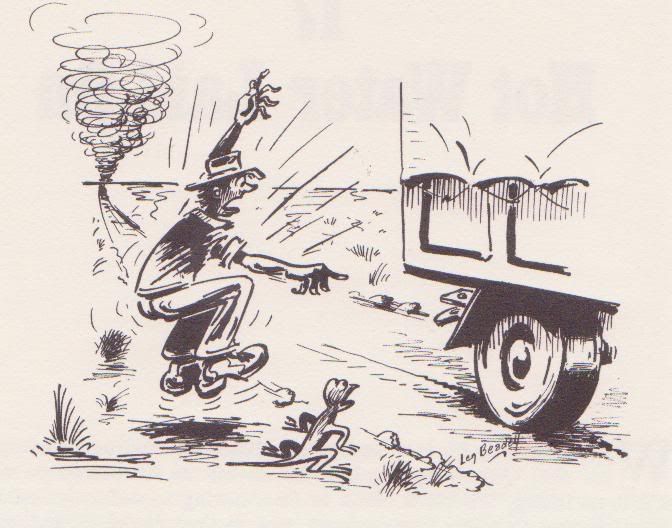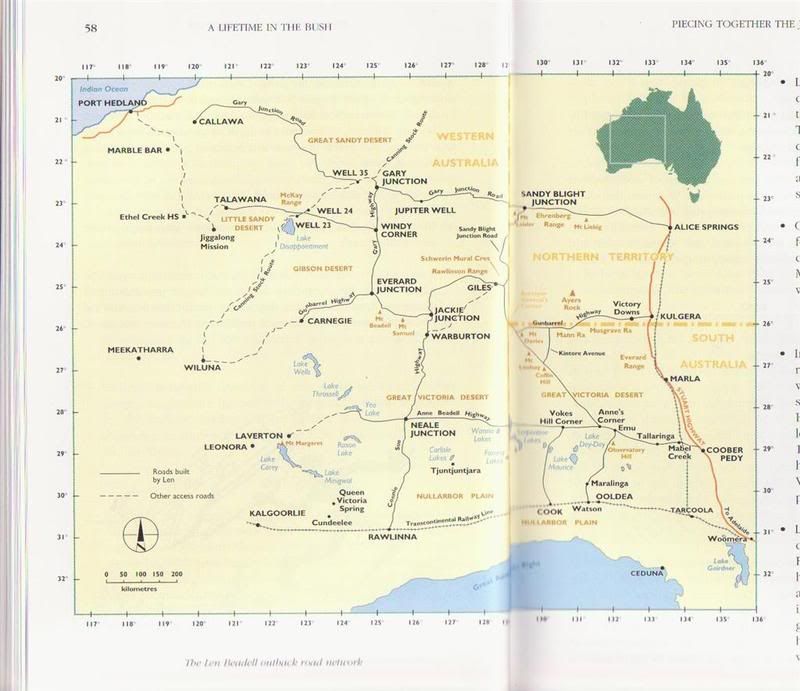Here’s one of my long winded posts. I hope some of the watchers and lurkers on this site may find it interesting..
Or - retitle this post as -
“How to Make a Long Story Out of One Picture of a Caravan”.The first picture below is the crew of -
“The Gunbarrel Road Construction Party” - (GRCP)..
This picture was taken somewhere in an Aussie outback desert - probably in the 1950’s.
Note the caravan at the left of the picture..

The background of the picture is as follows..
Len Beadell was a surveyor - he was an extraordinary man who, before being discharged from the army after WW2, did astronomical observations and survey work for a new series of army maps.
Len was then asked to waive his discharge and spent two years doing survey work for the CSIRO around Darwin and Katherine. He was later employed by the (then) ‘Commonwealth Department of Supply’.
What he thought would be a project lasting a few months ended up becoming a lifetime career.
Len had the job of surveying town sites for the Woomera Township and Giles Weather Station, as well as camps at Emu Field and Maralinga in the Great Victoria Desert in SA.
The latter two were atomic testing sites, carried out in The Great Victoria Desert.
Len also surveyed a 7000 km track network in the remote deserts of Central Australia and headed the team who built the outback track network..
He has often been called -
“The Last Australian Explorer”Len gave the unofficial name of ‘The GRCP’ to the small crew of men who, over about ten years, built the 7000 km network of tracks in remote desert areas of Australia, including the Great Victoria Desert, The Gibson Desert, The Little Sandy and Great Sandy Deserts.
The track network was built for access and possible recovery of rockets fired from Woomera Rocket Range.
The rocket firing range extended northwest from Woomera in SA, across the deserts to the west coast, around the Eighty Mile Beach area in WA.
The ‘GRCP’ crew also built access tracks west from Mabel Creek Station in SA (near Coober Pedy) to the atomic testing sites in The Great Victoria Desert, continuing west to Laverton in WA, and linking Rawlinna on the Trans Continental Railway to Warburton Settlement in the Gibson Desert.
The crew also built roads west of Ayers Rock to the location of Giles Weather Station and gave their name to
The Gunbarrel Highway - the rough track, west from Ayers Rock/The Olgas to Giles and onto Carnegie Station, then to Wiluna in Western Australia - the first road to link Central Australia to the West.
Back to the picture of the caravan..The caravan on the left of the picture (Possibly a Carapark?) served as sleeping quarters for some of the road construction crew for many years.
The caravan was towed by the camp supply/kitchen truck and each day the truck and van moved up to the head of the track, as the track was built.
This caravan would be
unique in not only travelling thousands of kilometres of remote outback tracks, but it was the first (and probably the only) caravan to have travelled on most of the remote outback ‘
Beadell Tracks’. The system of track building was simple - the team usually comprised eight men..
It couldn’t be done today with a ‘cast’ of under a hundred and at a thousand times the cost.
How the 'Gunbarrel' track building team worked..
Len flashed a mirror to give direction to Doug, the bulldozer driver..
Doug made one cut with the wide bulldozer blade..
Scotty then made three passes with the grader.
Willy then ‘cherry picked’ the track to remove any untidy spots by driving and walking the newly made track.
Paul the cook then drove the camp truck to the head of the road and towed the Carapark (?) caravan.
Rex, Bill and Quinny completed the team as heavy equipment mechanic and supply drivers.
Despite the hardships, the team took pride in the fact that every day they made maps of Australia obsolete by creating new roads to be added to later editions.
The grader that was used for over ten years on all the tracks is now housed at Giles Weather Station.
Len was also a superb bushman and a skilled artist. You can see examples of his cartoons when you visit Woomera or Giles Weather Station.
Len’s ‘signature’ on his sketches is the little bicycle lizard that appears in most of his cartoons..
About the cartoon below..One of the last sections of track built was the Gary Junction Road, which connects Alice Springs to the Canning Stock Route and continues on to connect up with the Northern Highway in WA.
One afternoon Paul the cook walked around the back of his truck.
He had a thought that something was wrong, but it took him a minute to realise the caravan wasn’t there.
The coupling had broken and the van was sitting on the track some miles back.
Len drew a cartoon of the event, as shown here..

Len Beadell died in 1995 but you can read about his adventures in Central Australia in the half dozen books he wrote, starting with -
“Too Long in The Bush” - first published in 1965.
An interesting aside is that Len's second book -
"Blast The Bush" seemed to miss a number of reprints..
It's an acount of the Atomic Testing at Emu and Maralinga..
One might think we (the public) shouldn't know anything about The British' effort to polute the deserts, and the subsequent stuff ups.. or am I just being synical?
Be warned, once you start reading Len’s books you’ll find them hard to put down.
There’s a memorial to Len on top of Mt Beadell in the Gibson Desert. It’s a small mountain (since named after him) that he first recorded when surveying the route of ‘The Gunbarrel Highway’ in 1958.
Beadell Tracks map..Here also is a map of “The Beadell Tracks” I’ve taken from Mark Shephard’s biography about Len, titled -
“A Lifetime in The Bush” - published in 1998.

The track network is an incredible legacy, due in no small part to the driving force of one man..
I’ve travelled a number of Len’s tracks over the years and my aim (as I approach senility), is to travel the rest of Len’s tracks.
I would also like to participate in Expeditions run by Connie Sue Beadell (Len’s daughter) and her partner Mick Hutton..
To that end my next (and last?) vehicle purchase needs to satisfy all needs, such as -
Be as fast and comfortable on the highway as a well set up ‘E’ series Falcon station wagon (or later model)..
Be able to tow vans and trailers I own (or may own) with great aplomb.
Be a stand alone rough track Four Wheel Drive, with onboard geriatric comforts accommodation and enough technologyto know where I am and not get too lost..
Further interesting reading can be found at:
www.beadell.com.auen.wikipedia.org/wiki/Maralinga,_South_Australia
en.wikipedia.org/wiki/Len_BeadellJim